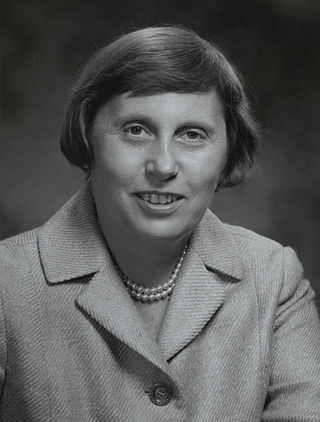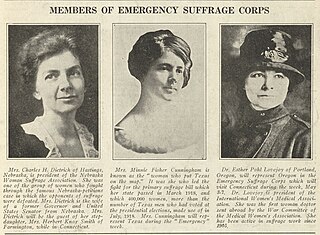
Emily Wilding Davison was an English suffragette who fought for votes for women in Britain in the early twentieth century. A member of the Women's Social and Political Union (WSPU) and a militant fighter for her cause, she was arrested on nine occasions, went on hunger strike seven times and was force-fed on forty-nine occasions. She died after being hit by King George V's horse Anmer at the 1913 Derby when she walked onto the track during the race.

Ella Rosa Giovianna Oliva Grasso was an American politician and member of the Democratic Party who served as the 83rd Governor of Connecticut from January 8, 1975, to December 31, 1980, after rejecting past offers of candidacies for Senate and Governor. She was the first woman elected to this office and the first woman to be elected governor of a U.S. state without having been the spouse or widow of a former governor. She resigned as governor due to her battle with ovarian cancer.

Isabella Beecher Hooker was a leader, lecturer and social activist in the American suffragist movement.

Ida Augusta Craft was an American suffragist known for her participation in suffrage hikes.

Katharine Martha Houghton Hepburn was an American feminist social reformer and a leader of the suffrage movement in the United States. Hepburn served as president of the Connecticut Woman Suffrage Association before joining the National Woman's Party. Alongside Margaret Sanger, Hepburn co-founded the organization that would become Planned Parenthood. She was the mother and namesake of actress Katharine Hepburn and the grandmother and namesake of actress Katharine Houghton.

Elizabeth Jarvis Colt was the widow and heir of firearms manufacturer Samuel Colt, founder of Colt's Manufacturing Company.

Women's suffrage was established in the United States on a full or partial basis by various towns, counties, states and territories during the latter decades of the 19th century and early part of the 20th century. As women received the right to vote in some places, they began running for public office and gaining positions as school board members, county clerks, state legislators, judges, and, in the case of Jeannette Rankin, as a member of Congress.

The Connecticut Woman Suffrage Association (CWSA) was founded on October 28, 1869, by Isabella Beecher Hooker and Frances Ellen Burr at Connecticut's first suffrage convention. Its main goal was to persuade the Connecticut General Assembly to ratify the 19th amendment, giving women in Connecticut the right to vote. Throughout its 52 years of existence, the CWSA helped to pass local legislation and participated in the national fight for women's suffrage. It cooperated with the National Women's Suffrage Association through national protests and demonstrations. As well as advocating for women's suffrage, this association was active in promoting labor regulations, debating social issues, and fighting political corruption.

Josepha Newcomb Whitney was an American clubwoman, pacifist, suffragist, and politician.
Emily Jane Harding Andrews (1850–1940) was a British artist, illustrator and suffragette. She was a member of the Artists' Suffrage League.

Miriam Butterworth was an American educator, activist, and politician.

Katharine Ludington was an American suffragist. She was the last president of the Connecticut Woman Suffrage Association, and a founding leader of the League of Women Voters.

Emily Sophie Brown (1881–1985) was an American politician who in 1920 became one of the first five women elected to the Connecticut House of Representatives. Brown subsequently served as a New Haven County commissioner from 1922 to 1927. She was a centenarian.

Alice Pattison Merritt was an American politician who was the first woman to be elected to the Connecticut State Senate, in 1924. Reelected in 1926, she served in the senate from 1925 to 1929.

Catherine Mary Flanagan was an American suffragist affiliated with the Connecticut Woman Suffrage Association and later the National Woman's Party. She was among the Silent Sentinels arrested for protesting outside the White House in 1917.
Frances Ellen Burr was an American suffragist and writer from Connecticut.

Josephine Day Bennett was an American activist and suffragist from Connecticut. She was a member of the National Women's Party (NWP) and campaigned for women's suffrage outside of the White House, leading to her arrest. Bennett was also involved in other social issues and was supportive of striking workers.

Caroline Ruutz-Rees was a British–American academic, educator, and suffragist. Ruutz-Rees was very involved in the women's suffrage movement in Connecticut. She served as the first head teacher of Rosemary Hall. She was also a member of the executive board of the Connecticut Woman Suffrage Association (CWSA).

Elizabeth Daken Bacon was an American suffragist and educator. She served as president of the Connecticut Woman Suffrage Association (CWSA) from 1906 to 1910.

The Suffrage Emergency Corps was a special group of suffragists formed after nearly two-thirds of the states had ratified the Nineteenth Amendment to the United States Constitution. Only one more state was needed to ratify, and suffragists hoped they could convince Governor Marcus H. Holcomb to make his state of Connecticut the thirty-sixth. A team of women, sponsored by the National American Woman Suffrage Association (NAWSA) chose delegates from the other states to travel to Connecticut in early May 1920 to convince the governor to open a special legislative session to consider ratifying the amendment. The event garnered publicity, but it did not convince the governor to proceed with the session.


















